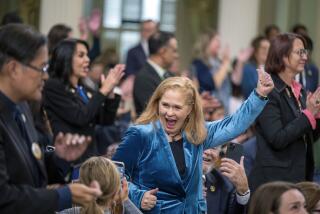Women make up nearly half of the California Legislature, setting a new record in Sacramento

- Share via
SACRAMENTO — Even in a state known for crafting first-in-the-nation progressive laws and leading on reproductive rights, men have long outnumbered women in the California Legislature.
The Capitol’s male-dominated culture was evident when hundreds of women spoke out about sexual harassment during the #MeToo movement. Then came the shocking image of a masked lawmaker carrying her newborn into the Assembly chambers during the depths of the COVID-19 pandemic because she was denied a request to work remotely after giving birth.
For the record:
4:53 p.m. Nov. 23, 2024An earlier version of this article misspelled the last name of Sade Elhawary.
It wasn’t until 1989 that a woman wore pants on the Senate floor, after a fed-up lawmaker defied the Capitol dress code on a cold day in Sacramento.
But now gender equality in California’s Capitol is nearer than ever, after voters elected a record number of women to the Legislature. When lawmakers are sworn in on Dec. 2, women will hold 59 of the Legislature’s 120 seats.
“They have an opportunity to exert power in a way that hasn’t been done before,” said Susannah Delano, executive director of Close the Gap California, which works to elect progressive women. “There’s a difference between lip service and good policy that is really vetted by the people who are going to be impacted, and women have a track record of powerful listening and inclusive, responsive solutions.”
The new record, with women holding 49% of legislative seats, marks a vast increase over the last decade. Women’s representation in the California Capitol is up from nearly 31% in 2020 and 25% in 2016, according to the Center for American Women and Politics. In 1980, just 9% of California state lawmakers were women.
For years, California has lagged behind other states — including Nevada, Arizona and Colorado — when it comes to legislative gender equity.
The change in Sacramento was fueled in part by major turnover in the Legislature this year, creating new opportunities for candidates to run without challenging an incumbent. More than a dozen of the newly elected women won seats held by men, many of who were forced out of office by term limits.
It comes after a majority of Californians voted for Vice President Kamala Harris over former President Trump and some are still reeling from the loss of what could have been America’s first female president.
Newcomer Sade Elhawary, a Democrat from South Los Angeles who is replacing termed-out Assemblymember Reggie Jones-Sawyer, is among the record number of women who will meet for a special legislative session in Sacramento next month to devise new ways to shield the state from Trump’s federal agenda.
She pointed to Trump’s history of sexual misconduct allegations that include a jury finding him liable for sexually abusing advice columnist E. Jean Carroll, which Trump has described as a “made-up, fabricated story.”
“Women in the Legislature are really going to be on the front lines as we look to both hold Trump accountable and protect Californians from all the things that might happen. I think we have to suit up,” Elhawary said. “We still suffer from the evils of sexism in such a real way.”
While Democrats are praising the gender gains as a way to further secure liberal priorities such as abortion rights, Republicans are also celebrating.
Suzette Valladares, a former assembly member who is replacing termed out Sen. Scott Wilk (R-Saugus) for the Santa Clarita Valley Senate seat, said working moms like her are well positioned to address Californians’ escalating concerns over the cost of living because they are attuned to family budgets and child care fees.
“When I served in the Assembly, we had a women’s caucus that truly was bipartisan. We made a conscious effort to support each other’s bills,” she said. “I think it’s going to produce some amazing pieces of policy.”
It’s hard to say if the shakeup in the Legislature will produce tangible reforms. California has already passed equal pay laws that do more to close salary gaps between men and women than most states and is home to the most stringent sexual consent requirements.
But some priorities of the Legislative Women’s Caucus have stalled as California faced a multibillion dollar budget deficit, including a bill that would have expanded Medi-Cal coverage of diapers vetoed last year by Gov. Gavin Newsom, who cited cost concerns.
Marva Diaz, a political strategist who mostly represents female candidates, said identity politics remain important to California campaigns despite the drubbing Democrats took nationally in this election, in part due to Trump’s strategy of appealing to young men.
“You recognize that you are different and that you are missing at certain tables. We need more women CEOs. We need more women in the business sector,” Diaz said. “I think that it’s going to take women in the Legislature in order to make that progress.”
The California Legislative Women’s Caucus was formed in 1985 and its founding members include Democratic Rep. Maxine Waters, a trailblazing and powerful member of Congress, and Rose Ann Vuich, the first woman elected to the state Senate who was known to ring a bell each time her colleagues in the Capitol addressed members as “gentlemen.”
State Sen. Toni Atkins (D-San Diego) made history in 2018 when she became the first woman and the first openly LGBTQ+ person to serve as the leader of California Senate. She was the first woman to lead both houses of the state Legislature, having also served as speaker of the Assembly.
Now, she’s one of three women who have declared a run for governor in 2026.
Only men have ever served as California governor. Atkins said it is overdue for voters to put a woman in the state’s highest office, and not just for representation purposes.
“I think it matters that there are women in this race. I actually think women govern differently,” Atkins said. “I think we think about the bigger picture.”
More to Read
Sign up for Essential California
The most important California stories and recommendations in your inbox every morning.
You may occasionally receive promotional content from the Los Angeles Times.











